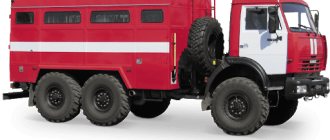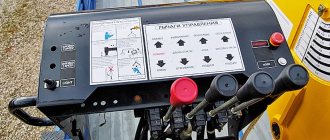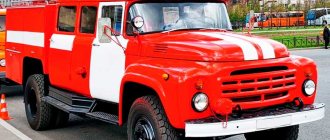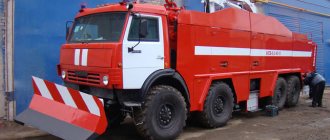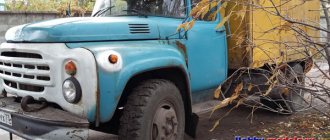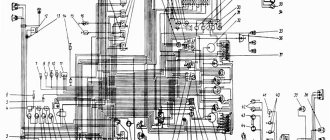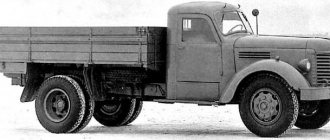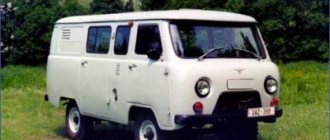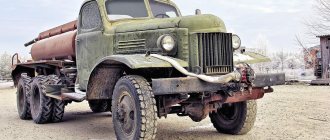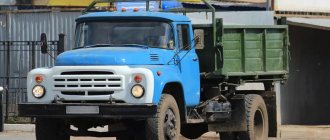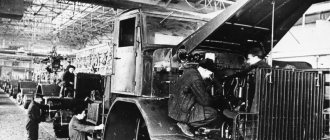For questions regarding the purchase of this equipment (ATs-40 fire tanker on the ZIL 433114 chassis), terms of credit and leasing, service and warranty, please contact the plant’s dealers or official representative offices. Delivery of the AC-40 fire tanker on the ZIL 433114 chassis can be carried out either directly from the manufacturer or from sites in Moscow and other regions of the Russian Federation.
Fire tanker ATs-40 on ZIL 433114 chassis.
ZIL fire trucks
The vehicles in service with the Ministry of Emergency Situations are produced on the basis of different car brands, but the ZIL platform is considered the most popular. Re-equipment to meet the needs of rescuers takes place at specialized factories and workshops. ZIL fire trucks fully comply with the tactical and technical characteristics of special equipment used to extinguish fires of various categories. The popularity of this brand is due to a number of factors:
- maneuverability when extinguishing fires in urban areas;
- maximum adaptation to operation in Russian conditions;
- maintainability;
- unpretentiousness to fuel quality.
The most popular models among the Ministry of Emergency Situations were models 130 and 131, as well as the legendary ZIL 157 fire trucks. Their regular modernization improves the quality of equipment and reduces maintenance costs.
Regulatory requirements
According to GOST 25478, the AC must undergo systematic inspections and repairs, as this directly affects road safety.
The procedure for carrying out repair work is observed in accordance with all requirements, and the materials and devices used comply with standards and have quality certificates.
Only those ACs that fully comply with the standards, have all the necessary documents and are functionally operational are allowed for operation on combat sites.
Attention! All ACs must be marked, which is a carrier of information about the substance being transported and how the vehicle is operated. You can find the decoding and buy the marking signs themselves on the Internet.
Fire trucks ZIL 130
Over the entire period of its existence, the PA on the 130th platform produced 10 modifications of vehicles. The most popular fire truck today is the ZIL 130 ATs-40-63B. In terms of performance characteristics, it is the optimal vehicle for going out on calls in an urban environment. The vehicle is used to deliver personnel, special equipment and additional equipment to extinguish fires. The advantage of these cars is a 2.4-ton water tank, as well as an additional 170-liter foam concentrate tank.
The AC-40-63B cabin has two rows of seats for personnel of 6 people. For the efficiency of fighters, four doors are provided. The driver's seat is adjustable according to the height and weight of the rider. The seats for passengers are stationary; underneath there are boxes for tools and personal equipment.
To save space, compartments for hoses were installed on the roof of the cabin. The sleeves in the basic set are 348 meters long. Special equipment and supplies are stored in the side compartments of the body.
Two types of pumps are installed on the AC-40 PA:
- single-level centrifugal PN-40UA rear position;
- single-stage normal pressure NTsPN-40/100.
They are located in the rear of the car. In addition to the pump, the fire installation includes a manifold, a foam mixer and pressure valves. For operation at night, the tanker is equipped with a lighting and alarm system.
The advantage of this model is a gasoline eight-cylinder four-stroke engine with a liquid cooling system. Fuel consumption per 100 km is 41.5 liters. When fully loaded, the car reaches a speed of 80 km/h. To strengthen the structure of the machine, it was placed on a spar frame made of low-alloy steel 30T. The front part was reinforced with braces, and above the rear axle beam the spars were equipped with reinforcing inserts.
The suspension is dependent, on springs and telescopic shock absorbers. Gable wheels were installed at the rear. This gave the car additional stability and off-road capability, which is important when going on call in rural areas. In the latest modifications, the AC-40 received arched tires on the drive axle and a winch on the bumper. Overall dimensions of the machine (l*w*h) – 7680*2500*2780 mm. Weight when fully equipped – 9600 kg.
The basic package includes equipment for the combat crew, breathing apparatus, HBP with connecting fittings, pressure hoses DN51, 66, 77. Portable monitor barrel, manual combined, overlap and air-foam barrels. Water collector, hydraulic elevator, keys, connecting heads. Foam generator GPS-600. Powder fire extinguishers.
Body
Light class fire fighting tanker ATs-0.8-40/2 (530104) model 002-MM
- All-metal, welded, equipped with aluminum shelves and panels.
- The compartments are equipped with curtains and doors manufactured by PO Bereg.
- Retractable carriages for hydraulic tools and electrical power equipment are installed in the front part of the body.
Design and technical characteristics of the TOP-2 domestic fire fighting vehicles ZIL
The ZIL firefighter is considered the most common and efficient vehicle in the domestic fleet of the Ministry of Emergency Situations. It moves quickly and carries specialized equipment necessary to extinguish fires. Compared to other brands of rapid response trucks, the vehicle on the ZIL chassis is unpretentious in maintenance, easy to operate, adapted to different conditions, and has good maneuverability and maneuverability in difficult areas with a relative minimum of space.
Pumping unit
The vehicle was equipped with fire pumps PN-40UA, and later PN-40UV. The productivity of pumping units of this type is 40 l/s, the created pressure is 100 m. Also, often during major overhauls in the late 1990s, more modern pumps were installed on the AC-40(130)63B - such as NTsPN-40/100.
In the mid-1980s, especially for the Moscow Fire Department garrison, a batch of AC-40(130)-63B equipped with a German combined Magirus P516H pump with normal and high pressure stages was produced.
All AC-40(130)-63B had a standard mount for the RK-4A hose reel. But in practice it was not taken out often.
Design
The fire truck includes a ZIL chassis and fire superstructures with the following equipment:
- cabin for combat crew;
- pumps;
- car stairs;
- tanks for fire extinguishing materials;
- departments for fire-technical equipment (FTV).
A liquid tank is attached to the platform in the cradle, and the body is attached to the bracket consoles. The solid metal cabin provides 7 seats for fighters and the driver. A fire pump is built into the subframe behind the tank. The mechanism is driven by cardan shafts from the PTO on the gearbox.
The fire installation consists of a pump, a manifold, a foam mixer and pressure valves. The compartment has a foaming tank. The tanker is equipped with additional electrical equipment for lighting and signaling.
ZIL-130
The most common tank truck is the AC-40-63B based on the ZIL-130 - a modernized version of the AC-30(130)-63A. Compared to the previous model, the tank and foam tank capacities increased, the body became wider, decorative trims were not installed on the wheel arches, the pressure pipes were hidden inside and covered with hatches.
During the mass production of tanks, design changes were constantly introduced. So, at first the cars had a “low skirt” that formed the wheel arch. Since the late 80's there was no window installed on the pump compartment door, then the back wall was straightened and no longer bent.
The design features of the modern fire engine AC-40-63B are as follows:
- 2-row, 4-door cab with panoramic windshield;
- water tank - 2360 l and foam tank - 170 l;
- steel body with compartments for PTV and canisters for suction hoses;
- single-stage centrifugal pump PN-40UA in rear position or single-stage normal pressure pump NTsPN-40/100;
- mount for hose reel RK-4A.
To increase cross-country ability, arched tires are installed on the drive axle of the vehicle, and a winch is installed on the bumper.
ZIL-131
AC-40(131)-137 has the following design:
- improved 2-row, 4-door cab with large rectangular door windows;
- the presence of an installation for heating water in the tank using exhaust gases;
- gasoline carburetor engine A-76;
- centrifugal single-stage fire pump PN-40UV;
- water-jet ejector-type foam mixer PS-5;
- gas jet or air suction mechanism;
- protective bars on windows in case of riots to disperse the crowd.
conclusions
Fire tankers are indispensable when fighting fires. This equipment effectively copes with the tasks of delivering anti-aircraft weapons and combat crews to the scene of an incident, carrying out fire extinguishing and performing rescue operations.
The installation and operation of tank trucks is strictly regulated by law, and any deviation from the norm is suppressed.
Every year, AC designs are only improving, new mechanisms are being added, and capabilities are being improved, which has a positive effect on the fire extinguishing process.
Specifications
Technical characteristics of the fire engine ATs-40-63B:
- Engine power - 110 hp. With.
- The maximum driving speed is 90 km/h.
- The length of the pressure hoses is 348 m.
- The area for extinguishing with medium expansion foam is 83 m².
- Pump capacity - 40 l/s.
- Head - 100 m.
- Number of hand barrels - 6 pcs.
- Supply of pressure hoses - 18 pcs.
- Fuel tank - 150 l.
- Fuel consumption per 100 km - 41.5 liters.
- length - 7680 mm;
- width - 2500 mm;
- height - 2780 mm.
- Tank volume - 2400 l.
- Foam tank capacity - 150 l.
- Engine power - 150 hp. With.
- The highest speed is 80 km/h.
- Fuel tank capacity - 170 l.
- Extinguishing volume - 125 m³.
- Pump flow - 40 l/s.
- Head - 100 m.
- Water flow in the fire monitor is 19 l/s.
- Fuel consumption per 100 km - 40 liters.
Among the transportability parameters of the AC-40(131)-137, the height stands out, which, without taking into account the combat crew, water and foaming agent in the transport position, reaches 2950 mm.
Features of connecting to a hydrant
The installation of the AC on a water source (hydrant or reservoir) begins only after the order of the fire operation commander “Put the tanker on the hydrant.” After this signal, it is possible to connect the hoses to the hydrant.
On a note. If the AC is installed on an open water source (for example, a lake), then there is a different principle of operation, where the intake of liquid and installation of the AC begins only after the command “Place the tank truck on the reservoir.”
AC is installed on the hydrate using the following methods:
- Instant connection of hoses.
- Connection to parallel suction lines.
- Mixed connection to suction and pressure hose.
Fire tanker AC 40 130
The fire tanker is manufactured on the basis of ZIL trucks, on the platform of which special equipment is installed.
The ZIL vehicle base is unpretentious in operation and maintenance. Also, the tanker can be used in different climatic conditions; due to its maneuverability, it can be placed in the required position; its compactness allows it to extinguish fires in urban conditions, where free space is limited.
Repairing a ZIL car is inexpensive, and maintenance can be carried out by full-time mechanics.
A common brand is the ZIL 130 fire truck. 10 models of these vehicles were produced. A popular model is the ZIL ac 40 130 63b. This is an improved version of the 63A model. In the new model, the pressure pipes are placed inside the superstructure. This brand is equipped with a tank with a volume of 2360 liters and an additional tank for foam concentrate. The cabin is an all-metal structure with 2 rows of seats. On the roof there are canisters in which fire hoses are stored. Quick exit of firefighters from the vehicle is ensured by 4 cabin doors.
Specialized equipment is located in body compartments. There is a centrifugal pump at the rear of the car.
The rear wheels of the AC 40 130 63b are made in a dual-slope configuration, which ensures road stability and high cross-country ability of the tanker. For driving in rural areas, you can install arched tires. There is a power steering.
Changes were also made to the chassis. The tanker was produced with the brake system of KAMAZ trucks. Due to the fact that it was necessary to fill the brake system with air, the departure of the tanker truck was delayed.
The engine is 4-stroke, gasoline, V-shaped, installed in front of the cabin. Air is supplied to the engine through an air duct, which is connected to the air filter by a corrugated pipe.
In the 1980s, a batch of machines equipped with the German Magirus P516H pump was produced.
Brake system
- The brake mechanisms of the front wheels are disc brakes with floating double-cylinder calipers, double-shoe, the rear wheels are drum-type with two internal shoes.
- The drive is combined, pneumohydraulic with two independent circuits.
- Parking brake system - brake mechanisms of the working brake system of the rear axle, driven from a spring energy accumulator with pneumatic control or from a lever in the cab.
- Quick release system.
- Spare brake system - the brake mechanisms are the same as the service brake system and the parking brake.
- Auxiliary braking system - uses the engine without the use of special devices.
- Anti-lock braking system (ABS).
Specifications
In 1968, the AC 40 131 model was developed, based on the ZIL truck. During production, the machines were modernized and improved. All changes improved various qualities of the car.
Technical characteristics and description of ZIL 131:
- type of chassis used - ZIL 131;
- wheel formula - 6*6;
- single-pitch wheel configuration;
- carburetor engine type;
- engine power - 110 kW, 150 hp;
- 7 seats;
- curb weight of the car - 11050 kg;
- water-foam extinguishing system;
- tank capacity - 2400 liters;
- foam concentrate capacity - 150 liters;
- monitor type - PLS-P 20 with foam nozzle;
- continuous foam supply time - 20 l/s;
- manual control of the monitor;
- water jet supply range - 50 m, foam jet - 60 m;
- the pump compartment is heated by exhaust gases;
- There is space for a radio station.
- maximum speed - 80 km/h;
- electric or gas siren;
- fire pump P N 40 UV.
Story
AC-40(130) model 63B is a modernized version of the AC-30(130) model 63A tank truck. Documentation for it was developed in 1977, and in the second half of 1978, serial production began with the release of an installation batch of 20 machines. Until 1982, both models (-63A and -63B) were produced in parallel. Moreover, the approved annual production plan for the AC-40(130)-63B was constantly being disrupted all this time, and the machines exceeded the plan for the old modification of the AC-30(130)-63A. Only by 1983 was the production of -63B able to stabilize. Then, over the course of several years, production growth only increased, reaching about 2,000 units per year in the second half of the 1980s. AC-40(130)-63B received a new enlarged tank with a volume of 2350 liters, instead of 2100 liters. model 63A, and an enlarged foam tank with a capacity of 170 liters. instead of 150 l. at -63A. As a result of these changes, the superstructure (body) became noticeably wider, which is why they abandoned the decorative trims on the wheel arches that were previously installed on the 63A model. Another noticeable difference between the -63B and -63A models was the pressure pipes. Now they have been removed inside the superstructure and closed with hatches. During the production of the AC-40(130)-63B, changes were made to the appearance of the superstructure to simplify its production. Cars manufactured 1978-1982. had a so-called “low skirt” that formed a wheel arch, which was later abandoned. Since 1990, the back wall has become straight, without bending. Since the late 1980s, machines without a window in the pump compartment door have been periodically produced.
There were also changes to the chassis. So, since February 1984, the ZIL plant switched to producing the ZIL-130 chassis with the so-called “Kamaz” braking system. But what was good for a regular truck became a big problem for a fire truck. Now, before each departure, we had to wait until the air needed to operate the braking system was pumped in. This took several minutes, which increased the time it took to respond to an alarm. Since 1986, in accordance with OST 37.001-269-83, the chassis of the ZIL-130 vehicle has received a new index ZIL-431412. But this did not affect the index of the fire tank - until the second half of the 1990s, it was produced under the previous name ATs-40(130)-63B. In September 1992, the ZIL plant stopped producing the ZIL-431412 chassis. In this regard, -63B produced in the mid-1990s were based on the UAMZ-ZIL-431412 chassis produced by the Ural Automotive Plant. A characteristic feature of these vehicles was the ZIL-131 cab on the ZIL-130 chassis.
Modifications
- ZIL-131 – basic modification;
- ZIL-131A is a version with unshielded electrical equipment, which it received from the ZIL-130. Its differences from the basic version were the absence of special military equipment, a middle bench in the body and a searchlight. Production of the car ended in 1971;
- ZIL-131V is a truck tractor built on the basis of the ZIL-131. The car had 2 spare wheels, a shortened frame and a fifth wheel coupling. The car was used to transport goods together with a semi-trailer weighing 12,000 kg (on dirt roads - 10,000 kg). Produced from 1968-1986;
- ZIL-131D – experimental chassis for dump trucks; did not go into mass production due to many shortcomings;
- ZIL-131D is a model with the same name and a Caterpillar engine, created in 1992. Its production lasted 2 years;
- ZIL-131N is a modernized version of the basic model. The main differences: a new ZIL-5081 engine, an increased service life (250 thousand km), an awning made of synthetic material and improved optics. Production of the ZIL-131N ended in 1987;
- ZIL-131NA – analogue of ZIL-131N with unshielded electrical equipment;
- ZIL-131NV - truck tractor with an improved platform;
- ZIL-131N1 – modification with a 105-horsepower diesel unit “D-245.20”;
- ZIL-131N2 – version with a 132-horsepower diesel unit “ZIL-0550”;
- ZIL-131S and ZIL-131AS are northern versions. These models were equipped with a cabin with an autonomous heater, frost-resistant rubber products, additional thermal insulation, fog lights, battery insulation and double glass. Cars were used in temperatures down to -60 degrees;
- ZIL-131NS, ZIL-131NAS and ZIL-131NVS - improved versions in the northern version;
- ZIL-131X - model for desert and hot areas;
- ZIL-131-137B – road train;
- ZIL-131 KUNG (unified body of zero dimensions) - an insulated building with a stove and an air purification station (FVUA-100N-12) can serve a wide range of military needs.
- ZIL-131-ATZ-3 – fuel tanker;
- ZIL-131-MZ-131 – oil dispenser;
- ZIL-131-ATs-40 – fire engine.
A special installation made it possible to maintain autonomous heating, which worked by burning working fuel.
Exterior and cabin
Like most of their models, ZIL made the “131” model with a hooded body layout. The cabin was externally an exact copy of the 130, only mostly all samples were painted khaki.
The design also remains all-metal. Proving to be impractical, the front part was replaced, and again with a ready-made one, only now from the ZIL-165. The bent fenders and intricate grille shape were replaced with simpler but strict elements.
In the 60s of the last century, such a design was akin to revolutionary, not to mention comparing the new model with the “157” model. For almost forty years, the appearance of the military truck changed only in small details. What catches your eye most is the new windshield, which has been made panoramic.
It was not advisable to hide the engine under the cabin, since this negatively affected several factors at once: access to the engine compartment in the field worsened, and if the engine was damaged during combat operations, an increased danger was created.
Considering the focus on army needs, the appearance was similar to its other brother in the class - Ural-375. There was one country, and enterprises were completely subordinated to the state. The main differences were different solutions to technical issues and engineering structures.
The body had typical characteristics, having on board two folding benches and one removable one. The sides cannot be folded down, except for the rear one, but this does not interfere with convenient shipping and loading.
To stretch the awning, you can install special arcs. The structure of the vehicle made it possible to install other modules instead of a cargo body, such as a field kitchen, a first-aid post, a radio station, and Katyusha and S-125 missile launchers; as well as civilians - a boom with a cradle, a fire truck.
It was comfortable to be inside due to several innovations. The already mentioned windshield has significantly improved visibility compared to the previous version of the “157”. Improved thermal insulation allows you to drive the car warmly, even in winter frosts.
The driver's seat was separate from the double passenger seat and was adjustable in height, reach and backrest angle. The dashboard has a minimum number of sensors that provide the driver with all the necessary information:
- Gasoline level;
- Voltmeter/ammeter;
- Speedometer;
- Oil pressure;
- Temperature level;
- Tachometer.
Of the controls, only one is located on the steering column - the turn lever. Large mirrors provide a good view of the rear view, reducing the blind spot to a minimum, even with a trailer.
Let's sum it up
35 years have passed from 1967 to 2002. During this time, the model in question was improved more than once, which had a positive effect on its performance. As a result, the “131” model, created at the Likhachev plant, received the highest award for the product - the USSR quality mark.
Despite the end of production and replacement with newer prototypes, the ZIL-131 is still found on the roads of the post-Soviet countries. Cars faithfully serve in various spheres of the national economy, realizing the plan set by the CPSU Congress back in 1959.
We advise you to read the article: ZIL - the history of the auto giant
Basic chassis
In the production of tank trucks, an important step is the selection of the chassis, since this set of units determines the functionality of the fire truck. The car chassis consists of 3 parts:
- Transmission.
- Chassis.
- Control mechanism.
There are 2 chassis schemes:
- The frame chassis consists of beams on which all machine components are installed. The frame design allows you to transport large loads.
- Load-bearing body. In order to reduce the weight of the car, the functions of the frame are transferred to the body. This design increases travel speed and provides comfort, but does not allow for the transport of large loads.
Frame structures are:
- spar;
- spinal;
- peripheral;
- lattice.
For the manufacture of vehicles, all-wheel drive and all-wheel drive truck chassis are used. All-wheel drive vehicles are equipped with tires for driving on dirt roads and on flat surfaces. It should also be possible to install anti-slip chains on the drive wheels.
The chassis of the ZIL fire truck has a spar frame and an increased level of reliability. The integrity of the supporting structure, when the machine is fully loaded, is ensured by special inserts that reinforce the side members.
The suspension can be dependent or independent. The main purpose of the suspension is to absorb vibrations while driving. The wheelbase consists of 6 driving wheels.
Pumping units were also produced on such chassis, which were replaced by ZIL fire trucks.
Advantages and disadvantages
The ZIL-131 car, like most Soviet vehicles from the 50s to the 70s, has a unique chassis that allows you to create the necessary modifications without unnecessary complications. Technical characteristics allow all systems to operate in the most extreme conditions, demonstrating their reliability. The truck was and is still used not only for military purposes, but also for civilian needs. The appearance of the car also contributes greatly to its current existence, since its simplicity and the presence of everything necessary were attractive both in the years of its creation and now.
Despite the clear advantage of the ZIL-131 over the ZIL-157, the second was produced for another 20 years from the moment the successor appeared.
A negative quality is the gradual aging of the model. Increasingly higher demands and more complex tasks are emerging. In this regard, in 2002 ZIL-131 was discontinued. Also, running on gasoline makes this car extremely uneconomical, and diesel versions are almost impossible to find. The price issue will be a minus for some, and a plus for others. A ZIL-131 with low mileage and in good condition can be bought within a radius of 160-270 thousand Russian rubles. Various modifications, taking into account the cost of the module, can reach a price of 600 thousand rubles.
